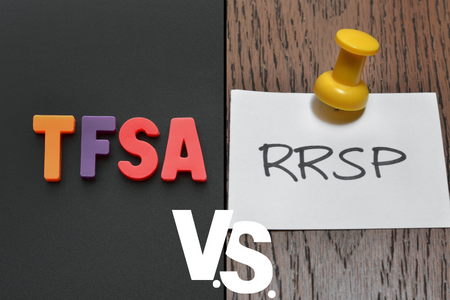Welcome To Our Mortgage Educational Blog About:
Should we take money from our RRSPs, TFSAs or both to make a down payment on our first home?

Are you debating whether to use money from your RRSPs, TFSAs, or both to make a down payment on your first mortgage?
Choosing whether to use your RRSPs or TFSAs to purchase your first home can be a difficult decision.
On one hand, you have access to your TFSA and RRSP savings up front, but on the other hand, if you use all of your RRSP room first, you won’t be able to make any more contributions until you’re over the age of 71.
Both RRSPS and TFSAs have advantages and disadvantages, so it’s only fair to be aware of them before making a decision.
This post will weigh the pros and cons of these options and provide you with a clear picture of which is best for you, so let’s get started.
What is a TFSA?
A Tax-Free Savings account (TFSA) is a type of account which allows you to save money and earn investment income for the rest of your lifetime. With a TFSA account, you do not have to pay taxes on any income or withdrawals from your investments.
What is an RRSP?
An RRSP (Registered Retirement Savings Plan) is a retirement savings plan that allows you to set money aside for retirement. With this account, you don’t have to pay taxes on your money as long as it stays in the RRSP.
However, when you decide to withdraw money from your account, it is treated as a withdrawal from a registered account, and therefore, you must pay tax on it.
RRSP benefits for first time home owners
RRSP accounts have proven to be of benefit to many first time home owners. By having this account, you are assured of the following benefits:
Tax-free savings
One of the reasons why RRSP accounts are so common for first time homeowners in Canada is because they allow you to save and withdraw up to $25,000 from your RRSP without paying any tax on the withdrawal!
However, once you retire and start spending your savings, you are required by law to pay taxes on any previous withdrawals.
Homebuyer’s Plan
If you have already contributed to your RRSP but have not yet withdrawn any amount from it, you may be eligible for the Home Buyer’s Plan (HBP).
This program allows first-time home buyers to borrow up to $25,000 from their RRSP for a down payment on a new home or for land purchase.
That said, letus look at…
TFSAs Benefits to first home buyers
Some of the benefits of a TFSA accounts to first time homebuyers include:
Tax-Free Compounding
As aforementioned, any investment made under the TFSA account is tax-free. Therefore, you can expect your investment to compound faster without the fear of annual tax.
Remember, tax-free compounding is worth millions. So, it follows that the more you invest, the higher your returns. This is because your money is not imposed on any tax drag. Therefore your savings are able to grow faster than in an RRSP account.
Withdrawals are not restricted
In case you need to make any withdrawal your money will be credited to your contribution room the following year. This means that you can withdraw money from your TFSA, tax free. You can also transfer funds between TFSAs with no restrictions or penalties anytime you wish to.
Share Contribution Space With Your Spouse
One good thing about TFSAs is that each member of a couple may contribute $5,500 per year to an RRSP or TFSA (or both). If both spouses contribute that amount annually for five years, they will have saved $27,500 for a down payment on their first home, thus enabling them to get it with ease!
No barrier to withdrawal
TFSA accounts are also well known for their flexibility in that its customers are able to save and withdraw their money anytime. Even better, the money they save grows automatically, meaning that you will end up withdrawing more than you initially saved.
Other advantages TFSAs include
- Withdrawals won’t Impact Government Benefits
- Unlike an RRSP’s forced withdrawal at age 71, there is no mandatory withdrawal with TFSAs
- Regardless of income, the contribution room is the same
- There is no death tax
Drawbacks of RRSP for a first time home buyer
The repayment period is 15 years
One of the greatest disadvantages of saving through RRSP accounts is that once you withdraw money from your RRSP, you must repay it within 15 years. Immediately you withdraw any funds, they are automatically added to your income, taxed at your marginal rate, and then deducted dollar for dollar from your RRSP.
Long-term growth potential is lost
Once you withdraw funds from your RRSP account, you forfeit the opportunity for long-term growth. This is because you can’t put that money back in without paying taxes or penalties.
HBP repayments are not deductible
The Home Buyer’s Plan (HBP) allows first-time home buyers to withdraw from their RRSPs without paying any income tax until they sell their home or become non-residents of Canada. However, HBP repayments cannot be deducted from your tax return.
Drawbacks of TFSA to first time home buyers
Some of the drawbacks of a TFSA account include:
There is no tax break
If you’re saving for retirement, you can contribute to an RRSP and get a tax break on the amount you put in. However, a TFSA will not provide you with the same benefit.
There is no creditor protection
If you have debts, creditors can take your money without paying any taxes or penalties. They cannot, however, touch anything in an RRSP, even if it is worth more than $100,000.
No Barrier to Withdrawals
If you use your TFSA to save for a down payment on your first home, you can rest assured that there aren’t any restrictions imposed on accessing the funds in the event of an emergency.
The Canada Revenue Agency will not penalize you if you withdraw your savings at any time.
Furthermore, if you keep the money in a TFSA, it will continue growing tax-free until you need it.
Here is the catch.
Although this appears to be a benefit, it is a disadvantage because it allows you to raid your retirement savings thereby crippling your growth financially.
Wrap up: RRSPs, TFSAs, which is the best for first-time home buyers?
Should we use funds from our RRSPs, TFSAs, or both to put down on our first home?
Sadly, there is no simple answer to this question because many factors come into play.
If you have a substantial amount of money saved in an RRSP or TFSA, withdrawing it may mean that you will never be able to replenish those funds (or at least not until later in life).
It is therefore preferable to use tax-free savings accounts because they allow more money to grow tax-free over time, unlike RRSP which limits your growth potential.
Therefore, after weighing the benefits and drawbacks of both RRSPs and TFSAs, you can easily choose an account that best suits you to make a downpayment for your home.
Are you ready to purchase your first home with your RRSP? Reach out to me directly or start your application here: www.sandraforscutt.ca/mortgage-application/
Don’t hesitate to contact us with any questions you may have.
Recent Educational Blogs
25-Year vs. 30-Year Mortgage
June 2025 | 25-Year vs. 30-Year MortgageIf you’re thinking about buying a home, one of the biggest decisions you’ll face is choosing your mortgage’s amortization period. Should you go for the traditional 25-year mortgage or take advantage of the newer, longer 30-year...
Thinking About Flipping a House in Edmonton?
May 2025 | Flip Mortgage ProgramAre you eyeing that “fixer-upper” in Edmonton and dreaming of turning it into a showstopper? House flipping is more popular than ever, and with the right mortgage program, it’s easier to get started than you might think!What is a Flip...
Unlocking the Value in Your Home
April 2025 | Home Equity Unlocking the value in your home can be a smart way to fund major renovations or get a handle on high-interest debt. If you’ve built up equity—the difference between your home’s current value and what you still owe on your mortgage—you may be...



